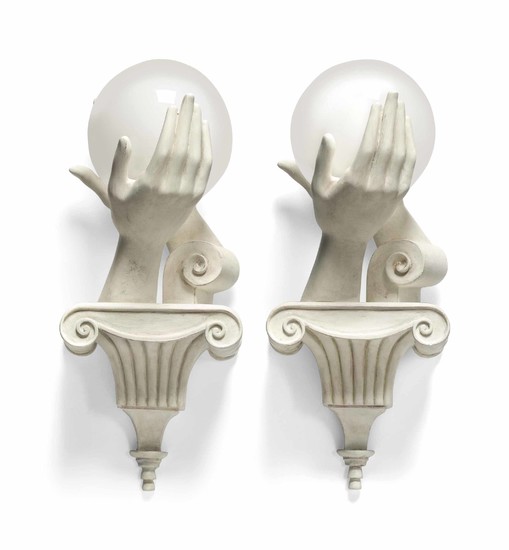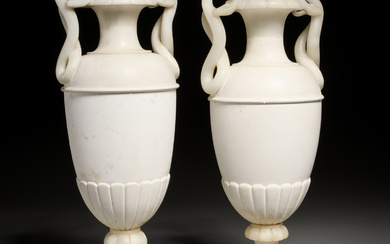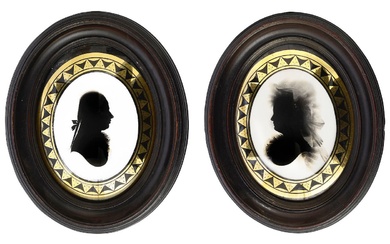A PAIR OF WHITE PLASTER AND MILK GLASS 'HAND' WALL-LIGHTS, MODERN, AFTER THE 1930S ORIGINALS BY NICHOLAS DE MOLAS
A PAIR OF WHITE PLASTER AND MILK GLASS 'HAND' WALL-LIGHTS
MODERN, AFTER THE 1930s ORIGINALS BY NICHOLAS DE MOLAS
Fitted for electricity
18 ¼ in. (46.5 cm.) high
A Great British Eccentric
?Ars longa, vita brevis?
Edward James (1907-1984) was a complex, gifted, and in many ways exceptional character whose quixotic life and legacy across the arts have earned his enduring reputation. Born in the glorious Edwardian era to substantial privilege, he demonstrated considerable imagination and independence of spirit, reinvesting this privilege in a life of personal creativity and of generosity and support to artists within his orbit. James is perhaps best known as a champion of Surrealism in the 1930s, not only as a collector and patron but also in his own, highly idiosyncratic perspectives. Yet his story is one with many intriguing facets through successive decades ? revealing him also as a poet, a publisher, a mystic, an impresario, and most consistently as a dreamer with the drive to pursue his extravagant ideas.
The setting for James?s crucial formative years was West Dean Park, the grand family estate in Sussex purchased by his father William Dodge James in 1891. The original Jacobean structure had been extended and elaborated in a neo-Gothic style in the early 19th century by the architect James Wyatt. For William James, West Dean was the fruit of an inherited fortune built by his father and grandfather in America through enterprise and a marriage that brought together important interests in timber and mining. William acquired many furnishings and artworks with the house, and added many more. The resulting environment ? the richly layered backdrop to his son Edward?s childhood ? was an eclectic mix drawn from across centuries and cultures, within an imposing edifice that itself represented multiple strata of history. From European armour to Egyptian shabti figures, from Georgian silver to Chinese blue and white, via paintings and artefacts of all kinds, West Dean provided an extraordinary source of stimulation to the curiosity and febrile fancy of the young Edward. Yet his childhood was not entirely idyllic, marked by the untimely loss of his father when Edward was only five, and by his less than ideal relationship with his mother, by all accounts a remote figure ? factors that pushed Edward to develop and find comfort in a lively inner world of his own construction.
James made his mark as an undergraduate at Oxford ? for his attention-catching personal style rather than his academic achievements. He took an extended suite of rooms at Christ Church and decorated them with flair and a certain delight in provocation, bringing together Flemish tapestries, lush silks, sumptuous colours, and Napoleonic wallpaper. He declared his devotion to the arts with the motto ?Ars longa, vita brevis? (?Art lasts, life is fleeting?) incorporated in a gold on black frieze in the drawing room, adding his own twist with the words ?sed vita longa si scias uti? (?but there is more to life if you know how to live it?). James?s high aestheticism and taste for poetic artifice were making themselves manifest. He was determined to lead his life on his own terms and within a world that was the product of artistry and romantic imaginings.
Passion has its own logic and perhaps the most significant event in the burgeoning of James?s unique sensibility was his infatuation with Viennese actress and dancer Tilly Losch. James met her in 1928. He was captivated by her persona. They married in 1931; but the marriage was fraught and very soon in trouble. After much tension, it was dissolved in 1934. Rather as Dorian Gray had fallen in love with an actress in the artifice and glow of the theatre, yet could not reconcile his ideal and his expectations with everyday reality, so James had projected his own fantasies onto Losch, but their relationship at a practical level was doomed. It nonetheless stimulated James?s involvement in Les Ballets 1933, an offspring of the late Sergei Diaghilev?s Ballets Russes, with a programme that James sponsored and helped develop as a platform for Losch. Les Ballets 1933 drew James into the world of the Neo-Romantic artists ? notably Pavel Tchelitchev and Christian Bérard ? who so effectively determined the look and the mood of this short-lived but significant venture. Their pictorial universe ? delicate, elusive, melancholic, dreamy ? struck a chord with James, as did the ephemeral magic of the world of dance and theatre. He valued performance, the intangible, temporal creative manifestation, as much as the lasting art work.
James had, meanwhile, taken a house in Wimpole Street that he refurbished to his own unconventional taste, immortalised in a photograph by Norman Parkinson in which James sits at his desk beneath fabrics draped from the ceiling across free-standing marble columns to which these generous swags are tethered with tasselled cords. The effect is of a stage set, calling to mind the desire expressed by James?s contemporary and fellow aesthete Cecil Beaton that he ?would like to live in scenery?. James?s search for visual, sensual, and spiritual experience that transcended the predictable or conventional found focus in his empathy with the Surrealists. He had shown a strong affinity with their artistic ideas even before June 1936, when, as art critic Herbert Read observed, ?the International Surrealist Exhibition broke over London, electrifying the dry intellectual atmosphere, stirring our sluggish minds to wonder, enchantment and derision.?
Already in 1935, James had published his novel, The gardener who saw God ? an expression of his own search for the transcendental. In that same year, he had set about adapting to his needs and to his whims Monkton House, a lodge designed by Sir Edward Lutyens on the West Dean estate. James added such bizarre flourishes as moulded drapes to the front of the house falling from upper windows, and bamboo-like drain pipes. Lutyens?s concept was overwhelmed by James?s predilection for fantasy and surprise. Already a champion of the Surrealist movement, James was expressing himself in an intuitive Surrealist vein. He was a contributor to, as well as a sponsor of, the movement?s journal, Minotaure; he collected and commissioned works; and, typically, he engaged with key artists, notably René Magritte and Salvador Dali. Aware of Dali?s financial straits, James made an offer in 1936 to support him for a year against works that he would create during that time. The close rapport with Dali led to the creation of emblematic three-dimensional expressions of the Surrealist spirit in the celebrated and deliciously disconcerting sofas inspired by the lips of Mae West, and the equally unexpected ?Lobster? telephone. These works survive as important tributes to Edward James?s courage and singularity as a patron.
The generosity that also defined Edward James is evidenced in his endowment of West Dean as a place of study and craft apprenticeship. James?s restlessness as a personality can be traced in his never-ending search for fulfilment through creative expression, reflected in his later years in his elaboration of a personal Xanadu deep in the jungle of Mexico ? the last of the many chapters in the artistic journey of a great British eccentric.
Philippe Garner
View it on
Sale price
Estimate
Time, Location
Auction House
A PAIR OF WHITE PLASTER AND MILK GLASS 'HAND' WALL-LIGHTS
MODERN, AFTER THE 1930s ORIGINALS BY NICHOLAS DE MOLAS
Fitted for electricity
18 ¼ in. (46.5 cm.) high
A Great British Eccentric
?Ars longa, vita brevis?
Edward James (1907-1984) was a complex, gifted, and in many ways exceptional character whose quixotic life and legacy across the arts have earned his enduring reputation. Born in the glorious Edwardian era to substantial privilege, he demonstrated considerable imagination and independence of spirit, reinvesting this privilege in a life of personal creativity and of generosity and support to artists within his orbit. James is perhaps best known as a champion of Surrealism in the 1930s, not only as a collector and patron but also in his own, highly idiosyncratic perspectives. Yet his story is one with many intriguing facets through successive decades ? revealing him also as a poet, a publisher, a mystic, an impresario, and most consistently as a dreamer with the drive to pursue his extravagant ideas.
The setting for James?s crucial formative years was West Dean Park, the grand family estate in Sussex purchased by his father William Dodge James in 1891. The original Jacobean structure had been extended and elaborated in a neo-Gothic style in the early 19th century by the architect James Wyatt. For William James, West Dean was the fruit of an inherited fortune built by his father and grandfather in America through enterprise and a marriage that brought together important interests in timber and mining. William acquired many furnishings and artworks with the house, and added many more. The resulting environment ? the richly layered backdrop to his son Edward?s childhood ? was an eclectic mix drawn from across centuries and cultures, within an imposing edifice that itself represented multiple strata of history. From European armour to Egyptian shabti figures, from Georgian silver to Chinese blue and white, via paintings and artefacts of all kinds, West Dean provided an extraordinary source of stimulation to the curiosity and febrile fancy of the young Edward. Yet his childhood was not entirely idyllic, marked by the untimely loss of his father when Edward was only five, and by his less than ideal relationship with his mother, by all accounts a remote figure ? factors that pushed Edward to develop and find comfort in a lively inner world of his own construction.
James made his mark as an undergraduate at Oxford ? for his attention-catching personal style rather than his academic achievements. He took an extended suite of rooms at Christ Church and decorated them with flair and a certain delight in provocation, bringing together Flemish tapestries, lush silks, sumptuous colours, and Napoleonic wallpaper. He declared his devotion to the arts with the motto ?Ars longa, vita brevis? (?Art lasts, life is fleeting?) incorporated in a gold on black frieze in the drawing room, adding his own twist with the words ?sed vita longa si scias uti? (?but there is more to life if you know how to live it?). James?s high aestheticism and taste for poetic artifice were making themselves manifest. He was determined to lead his life on his own terms and within a world that was the product of artistry and romantic imaginings.
Passion has its own logic and perhaps the most significant event in the burgeoning of James?s unique sensibility was his infatuation with Viennese actress and dancer Tilly Losch. James met her in 1928. He was captivated by her persona. They married in 1931; but the marriage was fraught and very soon in trouble. After much tension, it was dissolved in 1934. Rather as Dorian Gray had fallen in love with an actress in the artifice and glow of the theatre, yet could not reconcile his ideal and his expectations with everyday reality, so James had projected his own fantasies onto Losch, but their relationship at a practical level was doomed. It nonetheless stimulated James?s involvement in Les Ballets 1933, an offspring of the late Sergei Diaghilev?s Ballets Russes, with a programme that James sponsored and helped develop as a platform for Losch. Les Ballets 1933 drew James into the world of the Neo-Romantic artists ? notably Pavel Tchelitchev and Christian Bérard ? who so effectively determined the look and the mood of this short-lived but significant venture. Their pictorial universe ? delicate, elusive, melancholic, dreamy ? struck a chord with James, as did the ephemeral magic of the world of dance and theatre. He valued performance, the intangible, temporal creative manifestation, as much as the lasting art work.
James had, meanwhile, taken a house in Wimpole Street that he refurbished to his own unconventional taste, immortalised in a photograph by Norman Parkinson in which James sits at his desk beneath fabrics draped from the ceiling across free-standing marble columns to which these generous swags are tethered with tasselled cords. The effect is of a stage set, calling to mind the desire expressed by James?s contemporary and fellow aesthete Cecil Beaton that he ?would like to live in scenery?. James?s search for visual, sensual, and spiritual experience that transcended the predictable or conventional found focus in his empathy with the Surrealists. He had shown a strong affinity with their artistic ideas even before June 1936, when, as art critic Herbert Read observed, ?the International Surrealist Exhibition broke over London, electrifying the dry intellectual atmosphere, stirring our sluggish minds to wonder, enchantment and derision.?
Already in 1935, James had published his novel, The gardener who saw God ? an expression of his own search for the transcendental. In that same year, he had set about adapting to his needs and to his whims Monkton House, a lodge designed by Sir Edward Lutyens on the West Dean estate. James added such bizarre flourishes as moulded drapes to the front of the house falling from upper windows, and bamboo-like drain pipes. Lutyens?s concept was overwhelmed by James?s predilection for fantasy and surprise. Already a champion of the Surrealist movement, James was expressing himself in an intuitive Surrealist vein. He was a contributor to, as well as a sponsor of, the movement?s journal, Minotaure; he collected and commissioned works; and, typically, he engaged with key artists, notably René Magritte and Salvador Dali. Aware of Dali?s financial straits, James made an offer in 1936 to support him for a year against works that he would create during that time. The close rapport with Dali led to the creation of emblematic three-dimensional expressions of the Surrealist spirit in the celebrated and deliciously disconcerting sofas inspired by the lips of Mae West, and the equally unexpected ?Lobster? telephone. These works survive as important tributes to Edward James?s courage and singularity as a patron.
The generosity that also defined Edward James is evidenced in his endowment of West Dean as a place of study and craft apprenticeship. James?s restlessness as a personality can be traced in his never-ending search for fulfilment through creative expression, reflected in his later years in his elaboration of a personal Xanadu deep in the jungle of Mexico ? the last of the many chapters in the artistic journey of a great British eccentric.
Philippe Garner






